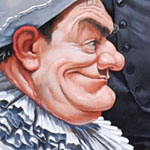
 (1873 - 1921)
(1873 - 1921)
Enrico Caruso, one of the most popular singers of the early twentieth century, was born in Italy in 1873. A specialist in opera, Caruso became one of the most popular tenors in history and was one of the most beloved musical stars of his time.
A large reason for Caruso's success was the fortunate timing of his career. He emerged at a time when recorded music began to be a popular purchase, and eventually made millions of dollars on over 260 recordings on 78rpm records. Although he was also a very popular touring acting, traveling and performing all over the world in his heyday, his fame was in large part a result of his ability to be heard by everyone regardless if they were able to attend a concert.
Caruso began his opera work in 1898, creating the role of Loris in Giordano's Fedora. A few years later he originated the role of Maurizio in Cilia's Adriana Lecouvreur. Both were performed at the Teatro Lirico in Milan.
With the help of his agent Caruso started his globetrotting in 1903, appearing as the Duke of Mantua in Verdi's Rigoletto with the New York Metropolitan Opera. Soon after he signed a contract with the Victor Talking Machine Company, the most popular manufacturers of phonographs and phonograph records of the time. This ended up being a lifelong partnership, one that was very successful for both parties.
Caruso also continued his work with the Metropolitan Opera, touring in their productions for much of his adult life. His most notable touring stint was with the show Carmen in San Francisco in April of 1906. The famous earthquake happened during his stay in the city, destroying nearly all of the set pieces and props the company had brought. Caruso managed to make it out of the city, first by boat and then by train, all the while clutching an autographed photograph of American president Theodore Roosevelt. He vowed to never return to San Francisco, and was true to his word.
During a performance of l'Elisir d'Amore in 1920 he suffered a hemorrhage, prematurely ending that night's performance. Indeed, he ended up only giving three more performances after that incident, with the final being Eleazar in Halevy's La Juive on December 24, 1920. Enrico Caruso died nearly eight months later, at the age of 48. The official cause of death was peritonitis. His life and career as a great singer and recording pioneer were remembered long after his death, and in 1987 he received a posthumous lifetime achievement Grammy.
Resources
Bolig, John Richard. Enrico Caruso: A History and a Discography. Denver: Mainspring Press, 2002.
Biography of the performer, including a very complete listing of all of Caruso's recordings.
Caruso, Dorothy. Enrico Caruso: His Life and Death. New York: Simon and Schuster, 1945.
Written by his wife, this biography of Caruso also contains a number of personal writings in the form of notes and of letters he sent to her.
Caruso Jr., Enrico and Andrew Farkas. Enrico Caruso: My Father and My Family. Portland: Amadeus P, 1990.
"Collected Works of Caruso." Internet Archive. 2001. http://www.archive.org/details/Caruso_part1 10 October 2007.
A fantastic website containing MP3 files of many of Caruso's recordings.
"Enrico Caruso." Wikipedia. http://en.wikipedia.org/wiki/Enrico_Caruso 7 October 2007.
In addition to the main information, this site also includes several audio files of Caruso's singing.
Freestone, John. Enrico Caruso: His Recorded Legacy. Minneapolis: T.S. Denison, 1961.
Another biography, this one focuses mainly on his contributions as a recording pioneer.